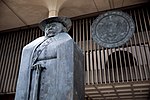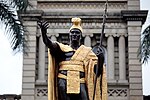ʻIolani Barracks
1870 establishments in HawaiiBarracks in the United StatesBuildings and structures in HonoluluGothic Revival architecture in HawaiiHistoric district contributing properties in Hawaii ... and 4 more
Military facilities in HawaiiNRHP infobox with nocatNational Register of Historic Places in HonoluluRomanesque Revival architecture in Hawaii

ʻIolani Barracks, or hale koa (house [of] warriors) in Hawaiian, was built in 1870, designed by the architect Theodore Heuck, under the direction of King Lot Kapuaiwa. Located directly adjacent to ʻIolani Palace in downtown Honolulu, it housed about 80 members of the monarch's Royal Guard until the overthrow of the Monarchy in 1893. It was added to the National Register of Historic Places in 1978 as part of the Hawaii Capital Historic District.
Excerpt from the Wikipedia article ʻIolani Barracks (License: CC BY-SA 3.0, Authors, Images).ʻIolani Barracks
Richards Street, Honolulu Hawaii Capital Historic District
Geographical coordinates (GPS) Address External links Nearby Places Show on map
Geographical coordinates (GPS)
| Latitude | Longitude |
|---|---|
| N 21.3075 ° | E -157.85888888889 ° |
Address
ʻIolani Barracks
Richards Street
96808 Honolulu, Hawaii Capital Historic District
Hawaii, United States
Open on Google Maps








